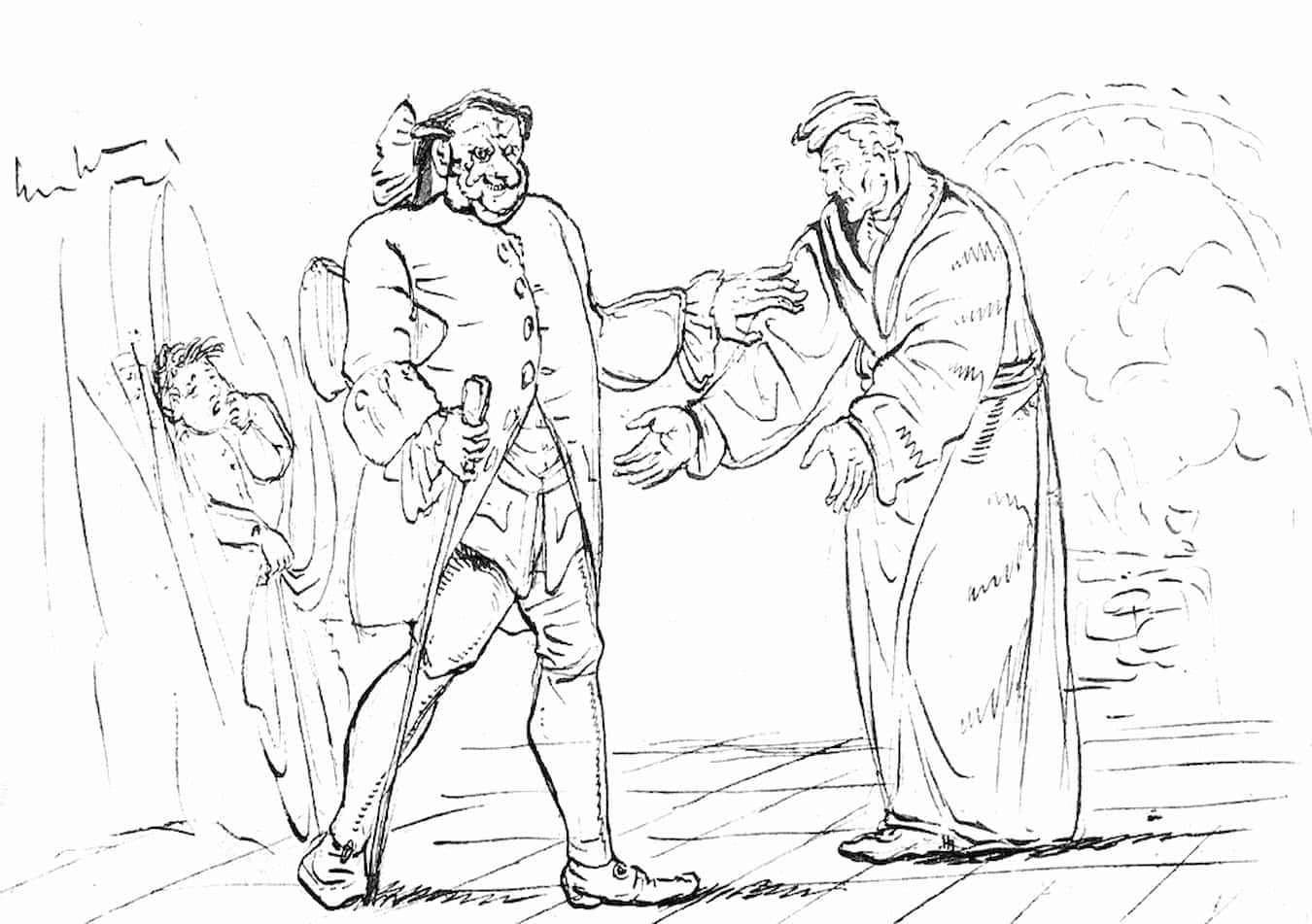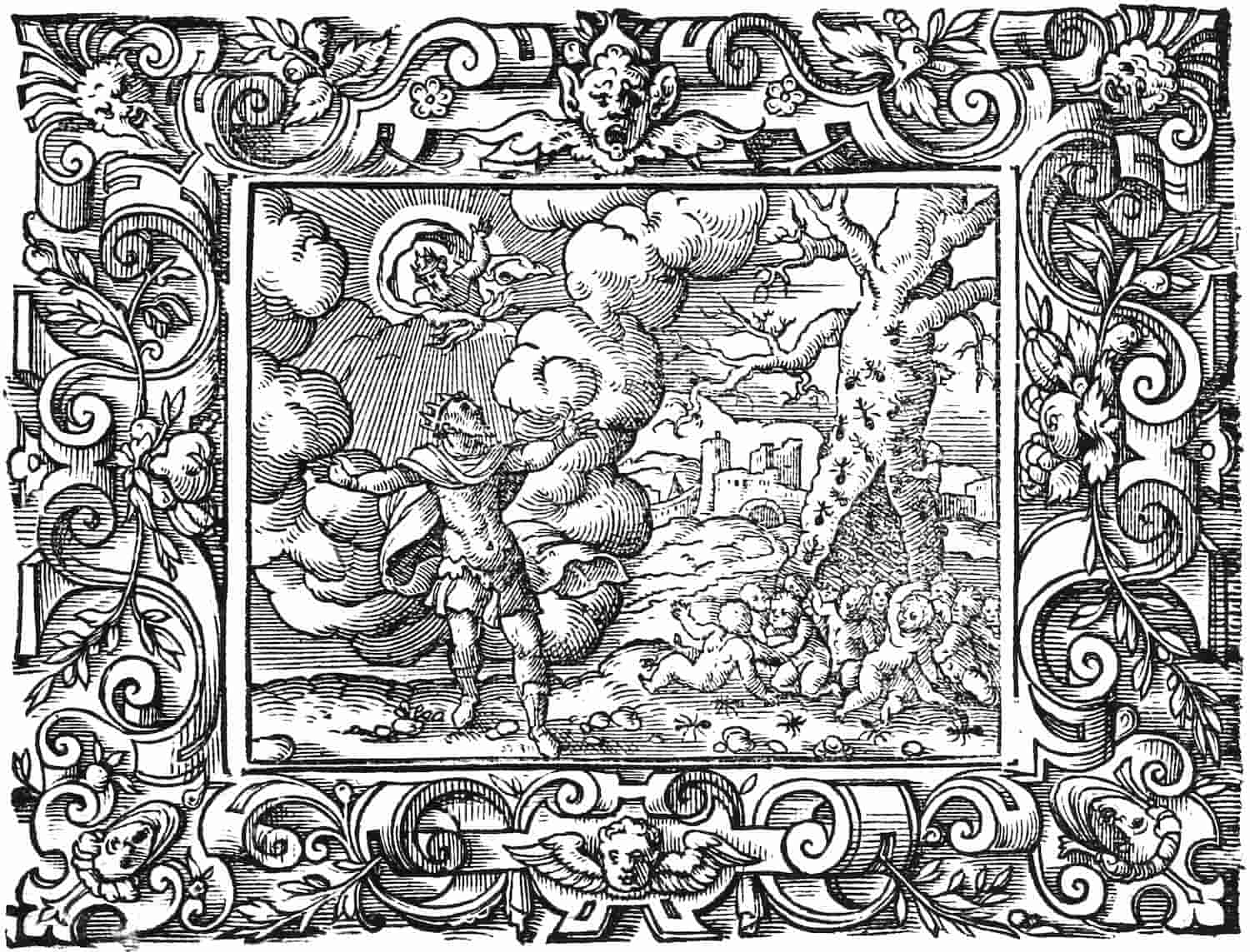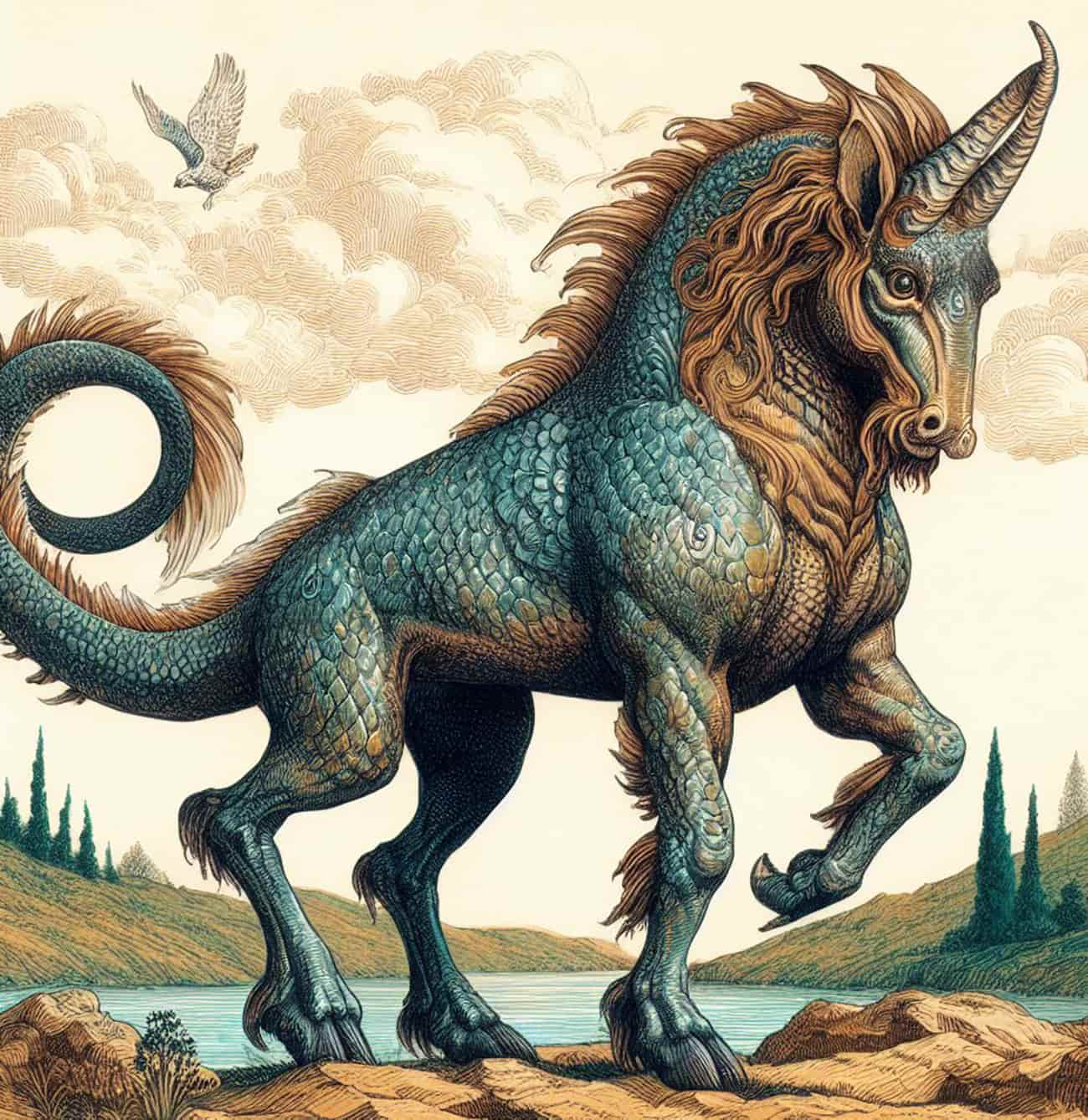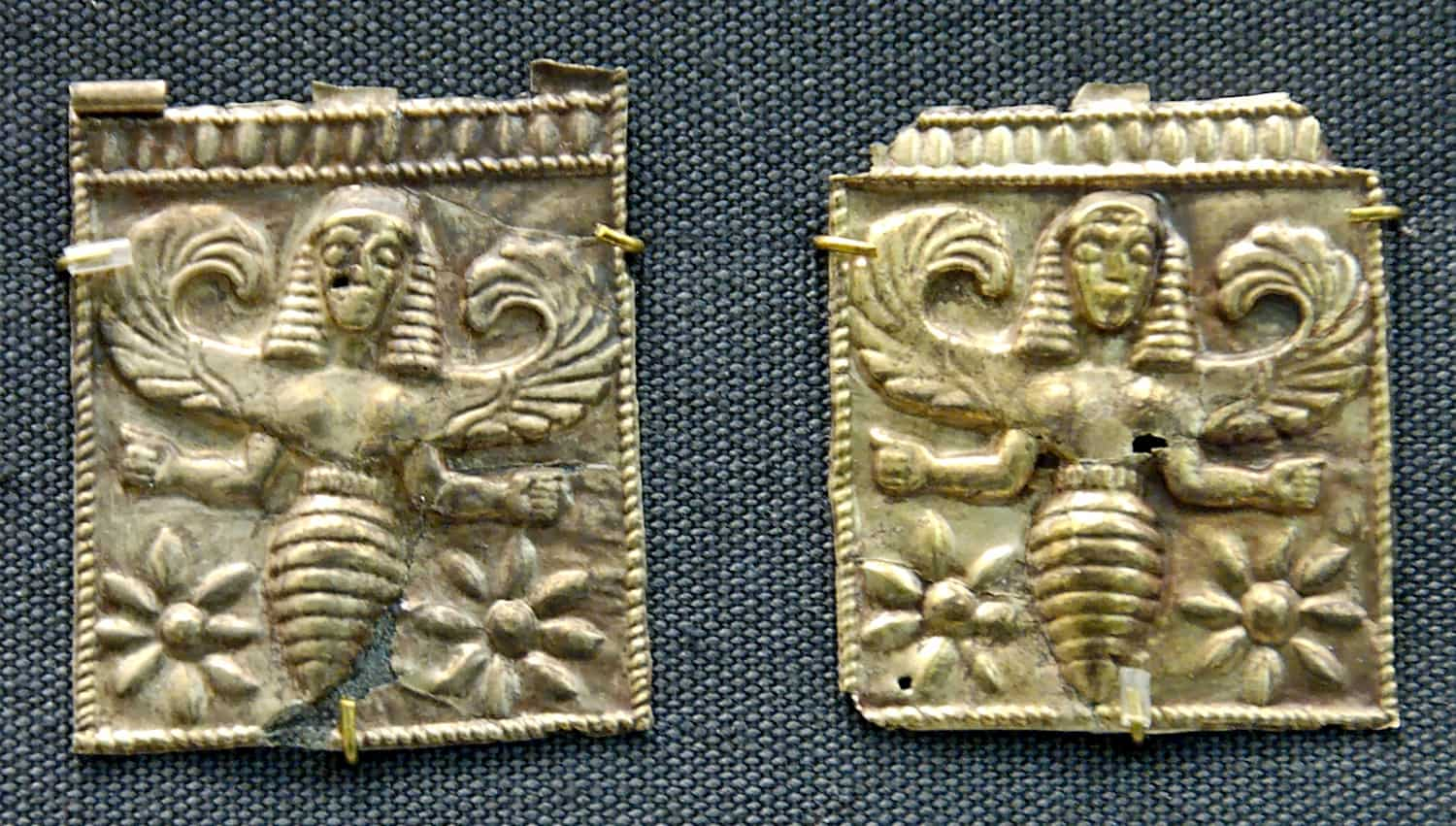The Sandman is a legendary figure in European mythology. According to tradition, he visits children in the evening, sprinkles sleep-inducing sand into their eyes, and creates dreams. People rub the sleep sand from their eyes in the morning. The series characters of East Sandman and West Sandman, created in Germany based on this legend, gained international media popularity.
Roots
The Celtic religion mentions the Genius cucullatus, a protective spirit and hooded demon. In Greek mythology, the Oneiroi bring dreams. They are a group of demons, sons, or brothers of Hypnos, resembling bats. Morpheus, a son of the god of sleep, Hypnos, is considered the responsible god of dreams and visions. He leads his brothers Phobetor (from the Greek word phobia, φόβος meaning “fear,” for nightmares) and Phantasos.
People receive messages in their dreams. For example, Morpheus appears at the command of Hypnos to Alcyone, who is sleeping and awaiting her husband, Ceyx, in the form of Ceyx, as he has fallen victim to a shipwreck. The entrance to Morpheus’s cave is surrounded by intoxicating herbs, such as the opium poppy. Sleep and death were considered siblings for the Greeks and Germans. In Greek mythology, Hypnos is the god of sleep, and his brother is Thanatos, the god of death.
The oldest evidence of the “Sandman” or “Sandmännchen” can be found in Johann Christoph Adelung’s Grammatical-Critical Dictionary of the High German Dialect in the 1811 edition.
Motif History
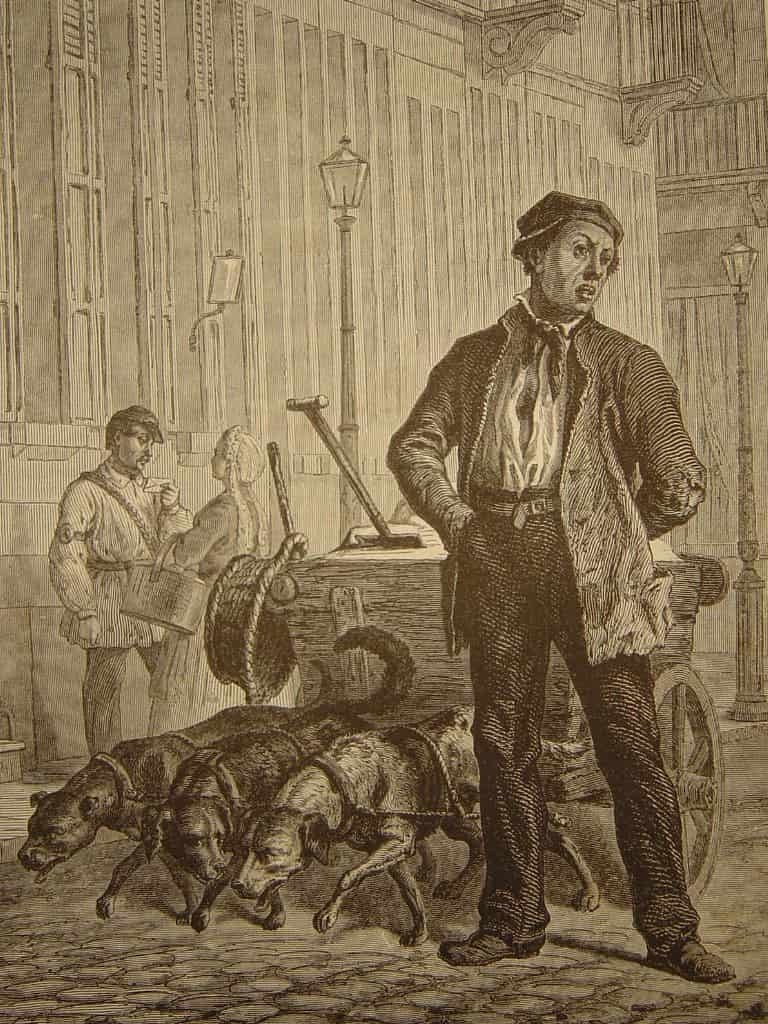
European literature indeed knows Morpheus as the dream god who scatters “slumber grains,” although the identification is not always clear-cut; sometimes, the god of sleep, Hypnos, is also assigned this role.
In tradition, two distinct variants of the Sandman figure can be distinguished: on one side, the eye-gouging demon, and on the other, the “eye-closing” figure who fabricates dreams. The concept of the Sandman also incorporates the figure of the sand seller, a traveling merchant who sold white sand as a cleaning agent.
The Boogeyman
Western European folklore presents a variety of frightening figures whose purpose was to lead children home in the evening or put them to sleep at home, such as the goat-like Night Buck, the Night Crab, the Night Cricket, the Boggart, the Night Raven, or in the Hunsrück region, the Night Owl. Their characteristics have to varying degrees influenced the literary portrayal of the well-known Sandman figure.
E.T.A. Hoffmann’s (1776–1822) eerie novella “The Sandman” portrays the Sandman figure as a typical traditional boogeyman figure, whose appearance spreads fear and terror. He uses sand as a dangerous and injurious weapon for the eyes. An old nurse, in contrast to the enlightened parents, vividly describes the Sandman to the inquiring child as:
“A bad man who comes to the children when they don’t want to go to bed and throws handfuls of sand into their eyes, so that they jump out bloody from their heads; he then throws them into his sack and carries them to the crescent moon to feed his little ones; they sit there in the nest and have crooked beaks like owls, with which they pick out the eyes of naughty human children.”
The Dream Bringer

The figure of the Sandman known today is essentially attributed to the Biedermeier adaptations experienced by the Danish fairy tale writer Hans Christian Andersen (1805–1875) based on the German tradition he knew. Andersen chooses the name of the character known in Danish as Ole Lukøje (“Ole Eye Closer”) for the title character. Regularly before bedtime, he visits children, closes their eyes with “sweet milk,” and tells them a story.
“There is no one in the whole world who knows as many stories as Ole Luk-Oie! He can tell them properly.”
From his two accompanying umbrellas, he unfolds the illustrated one over the “good” children, causing them to sink into lively dreams, and the other – without pictures – over the naughty ones, who consequently do not dream at all.
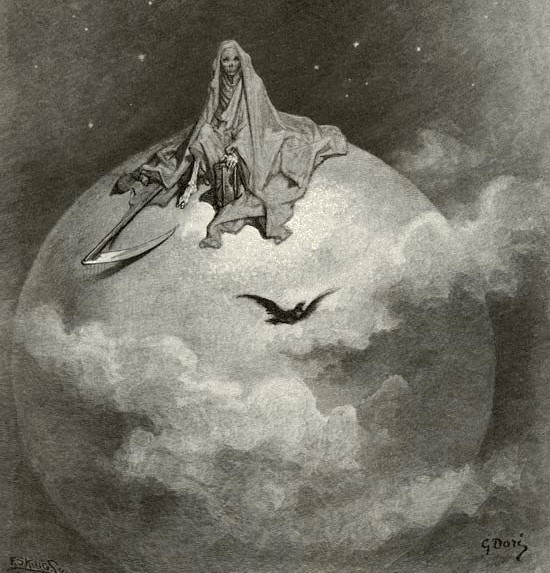
Hans Christian Andersen’s 1841 folktale, Ole Lukøje recounted the dreams he gave to a child in a week through his magical technique of sprinkling dust into children’s eyes. “Ole” is a common Danish name and “Lukøje” means “close eye”. Andersen wrote:
There is no one in the world who knows as many stories as Ole-Luk-Oie, or who can tell them so well. At night, while the children are sitting at the table or in their chairs, he climbs the stairs very gently, for he walks in socks, then opens the doors without the slightest noise and throws a small amount of fine dust into his eyes, just enough to prevent them from holding them open and not seeing him. He then crawls behind them and blows gently on their necks, until their heads begin to bow. But Ole-Luk-Oie doesn’t want to hurt them, because he likes children very much and just wants them to shut up so he can tell them nice stories, and they never shut up until they’re in bed and fall asleep. As soon as they fall asleep, Ole-Luk-Oie sits up on the bed. He is well dressed; Her coat is made of silk fabric; It is impossible to say what color it is because it changes from green to red and from red to blue when it is turned from one side to the other. Under each arm he carries an umbrella; One of them, with drawings inside, spreads them over the good children, and then they dream the prettiest stories all night. But the other umbrella has no pictures, and it holds it over the naughty children so that they sleep soundly and wake up in the morning without having any sleep.
Variants
Scandinavia
In addition to the Danish figure of Ole Lukøje, the figure of Jon Blund is known as the bringer of sleep in the Scandinavian region.
Netherlands
In the Netherlands, the traditional Sandman name Klaas Vaak is traced back to the old Dutch expression “vaak hebben” for sleeping.
Austria – Tyrol
Around Innsbruck, the Pechmandl (Pitchman) brings sleep. This little man has a rope or string in one pocket and a box full of pitch or resin in the other pocket. The Pechmandl sneaks behind the children and applies a little pine pitch to their eyes. This immediately causes their eyes to close, and they fall asleep. The purpose of Pechmandl’s string is unclear. Possibly, it indicates the complete immobilization of the limbs during sleep.
There was also an old Pechmandl song in Tyrol. However, it has been lost, and only the concluding rhyme remains:
“When the Pitchman comes with his string, He closes the child’s eyes”
Mister Sandman in Music
In October 1954, the single “Mr. Sandman” (Cadence Records 1247), sung by The Chordettes, was released. The song by Pat Ballard became their biggest hit. It entered the US charts on October 20, 1954, and reached number 1; in the UK, the single reached number 11.
The Chordettes were a US A-cappella girl group. The vocal quartet had eight top-20 hits on the charts between 1954 and 1961. During this time, there was a transition from popular music to rock ‘n’ roll. The Chordettes are considered prototypes for the numerous girl groups that followed them.
The song begins with the line “Mr. Sandman, bring me a dream / Make him the cutest that I’ve ever seen.” It addresses an erotic dream or daydream.
The theme of the Sandman is addressed in “Enter Sandman” by Metallica. Here, the Sandman is the bogeyman who brings nightmares. Also addressing nightmares, specifically the fear of imaginary monsters and an evil Sandman, is Rammstein’s “Mein Herz brennt.” Also, the song “Sandman” by the band America refers to a figure of terror, which here, however, is more to be understood as a symbol for inner fears.
The ability to bring dreams is also addressed in the song “Sandmann” by the band Oomph! Here, children wish to dream to escape reality. The song addresses child poverty in both its German and English versions.
The German band Saltatio Mortis depicts the ambivalence of the Sandman figure in their song “Der Sandmann” from the album “Das schwarze Einmaleins” by incorporating both the frightening and dream-bringing aspects. They mainly refer to the Germanic basis of the Sandman. The two sides of the Sandman are symbolized in the song, among other things, by describing the sand as white for bringing dreams and black for the sand that “hollows out” and kills the eyes.
The History of Sandman
The sandman is a legendary character tasked with putting children to sleep by sprinkling sand on their eyes. In the 19th and 20th centuries, there existed a craft activity that later became industrial, involving the extraction of sand and gravel from riverbeds to deliver them via land or waterways for masonry needs. The evolution of the profession and its various aspects led workers to become excavators, boatmen (as on the Canal du Midi), carters, and even truck drivers. These professions were then referred to as fisherman, dredgers, and sand merchants.
In Popular Culture
In multiple languages, reference works do not seem fixed on whether the sandman is a singular or multiple character. The character was combined with an expression: “avoir du sable sous les yeux” (having sand under one’s eyes), used in the 18th century.
The combination appears in a short story by Ernst Theodor Amadeus Hoffmann, “The Sandman,” published in 1817 in the collection “Night Pieces” (Nachtstücke). In some versions, especially Germanic ones, the character is not necessarily benevolent (indeed, the eyes close reflexively due to the irritation caused by the sand), as seen in the Sandmännchen of East German television.
It is worth noting the striking resemblance between the sandman and the elf from Hans Christian Andersen’s tale “Ole Lukøje” (in Danish) or “Ole Shut-Eye” in English (1805-1875). The sandman is referenced in “Marchand De Sable Qui Passe, Op. 13,” a composition by Albert Roussel in 1908 for string quartet, harp, oboe, French horn, flute, and clarinet. He is also depicted in the television show “Bonne nuit les petits” (Good Night, Little Ones).
In Other Cultures
- The sandman in French-speaking culture is inherited from the Sandmann of Germanic cultures, who is tasked with putting children to sleep by causing their eyes to sting with sand. He is also the origin of the Sandman in Anglophone culture.
- In Greek mythology, Morpheus and the other dream deities (the Oneiroi) are responsible for putting mortals to sleep.
- In Quebec, to send children to bed, one rather evokes the Bonhomme Sept-Heures. This character also carries a bag and in some versions, throws sand into the eyes, but the sand is used to blind in order to catch better, and the bag is where he imprisons children who do not go to bed.
- In Galicia, Pedro Chosco is an old man with a white beard and a voice so deep and sweet that he lulls babies to sleep and charms young girls.
- In Portugal, João Pestana is a shy character who arrives slowly when all is quiet, without making a noise.
Derived Expressions
- The sandman is passing: the feeling of sleep is felt.
- The sandman has passed: someone has fallen asleep.
- The sandman is going to pass: it is time to go to sleep.
- Having sand in one’s eyes: feeling sleepy.
Songs and Melodies
- In late 2021, Ed Sheeran released the song “Sandman,” dedicated to his daughter, Lyra Antarctica, born in August 2020.
- “Mr. Sandman” by Method Man featuring RZA, Inspectah Deck & Street Thug
- “Enter Sandman” by Metallica: “Till the sandman he comes”, “Exit light, Enter night”.
- “Mr. Sandman” by The Chordettes: “Mr. Sandman bring me a dream”
- “Sandmann” by the group Oomph
- “In Dreams” by Roy Orbison
- “Blood Red Sandman” by Lordi
- “Mein Herz brennt” by Rammstein
- “The Sandman’s Orchestra” is a French dark folk group.
- “Monsieur Sable” by French rappers Nekfeu and Alpha Wann.
- “Marchand de Sable” by rappers Djaja and Dinaz
- “Le Marchand de Sable” by rapper Black Kent.
- “Le Marchand de Sable” by Hippocampe Fou
- “Le Marchand de Sable,” poem by Jacques Fourcade, Music by Robert Planel (1935), melody for tenor or soprano, flute, harp, and string quintet or piano accompaniment, Editions Costallat (1939) (Editions Jobert ISBN / ISMN 9790230812665) (ref. JJ 12 665, 4 p.)
- The sandman is mentioned in “Petit Papa Noël” by the singer Tino Rossi.
Comics
– In comics, the myth of the sandman inspired the creation of two characters named Sandman. The first Sandman was created in 1939 by Gardner Fox; he belongs to the DC Comics Universe. The second Sandman is the main character of the Sandman series by English author Neil Gaiman, which narrates the adventures of the Lord of Dreams and his endless siblings.
Film and TV Series
- In a film of the same name directed by Steve Achiepo in 2023.
- In the television series Charmed, in the episode “Sand Francisco Dreamin'”, Sandman is introduced as a kind of angel who goes from person to person spreading his dust so that people can have dreams in which to solve their problems. Without the action of this being, conflicts between people increase. It is also shown that if more dream powders are spread than necessary, dreams materialize.
- The sandman appears as a guardian in the animated film “Rise of the Guardians.” He is depicted as a chubby man in a golden sand robe, his skin is orange and he communicates through images of sand that he conjures above his head. As he cannot speak, he is good with children and is friendly.
- In the television series Sleepy Hollow there is a character named Sandman who punishes those who do not help their neighbor, driving them mad until they commit suicide. For this, Sandman enters dreams by throwing his sand. The victim wakes up, mesmerized by Sandman’s power, and his eyes turn to total white. After the deaths of the victims, their eyes begin to turn to sand.
- In August 2022, the character “Sandman” appears in the Netflix original series “The Sandman”, based on the comic book written by Neil Gaiman.
- In 2023, a new LEGO TV series called LEGO DREAMZZZ premiered on Netflix, where at the end of chapter 14, the character of THE SANDMAN appeared.
- On September 18, 2014, at the beginning of the third episode of season 13 of the American series “Family Guy” Stewie, the baby, tells Brian that he has not slept well, that he even hired the SANDMAN to help him sleep, and a scene appears where the mythological character characterized as a magical fairy throws sand in his face repeating happily “Sandman, Sandman….” while Stewie remains in his crib with his eyes open.
Animated Series
- The sandman appears as an antagonist in an episode of the series “Martin Mystery,” trapping his victims in a deep sleep to make them live an endless nightmare.
- In an episode of the animated series Unikitty!, after bedtime, a character called “The Sandbox” appears who is in charge of throwing sand at those who stay awake to put them to sleep.
Books
- The sandman is an important character in the “Oniria” book series by B. F. Pary. He is named Amastan and, as the Sandman (which is a title), he rules Oza-Gora, which is the Land of Sand. He rules with an iron fist over the Sandmen, whose role is to put people to sleep around the world. He is also the former lover of Mamilou (the grandmother), the father of Patrick, and the grandfather of Elliott (the main character).
- The sandman is also one of the main characters in Gaïa Alexia’s novels, “Le Marchand de Sable,” which tell a love story between the goddess of the night Nott, and the god of the moon Mane (Màni in Icelandic). It also features other gods such as Sol, the goddess of the sun and sister of the god of the night, or Kvasir. Their goal in this work is to reunite two lost lovers and escape Odin’s omniscience.
E-books
- He also appears in an e-book titled “La mystérieuse histoire du marchand de sable” (The mysterious story of the sandman).
Video Games
- In the boxing video game series Punch-Out!! there is a character named “Mr. Sandman”. His phrases allude to “sending the player to sleep”.
- In Team Fortress 2, “The Sandman” is an unlockable melee weapon for the Scout. It’s a wooden bat with a soft black grip and a logo that reads “The Sandman.” This refers to knocking out or “sleeping” opponents.
- In the video games of The Strange Man saga, created by Uri, Sandman is the protagonist of the second installment.
- In the video game Brawl Stars, he is depicted as a teenager capable of controlling the arena named Sandy.


